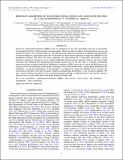Resonant absorption of transverse oscillations and associated heating in a solar prominence. II. Numerical aspects
Abstract
Transverse magnetohydrodynamic (MHD) waves are ubiquitous in the solar atmosphere and may be responsible for generating the Sun's million-degree outer atmosphere. However, direct evidence of the dissipation process and heating from these waves remains elusive. Through advanced numerical simulations combined with appropriate forward modeling of a prominence flux tube, we provide the observational signatures of transverse MHD waves in prominence plasmas. We show that these signatures are characterized by a thread-like substructure, strong transverse dynamical coherence, an out-of-phase difference between plane-of-the-sky motions and line-of-sight velocities, and enhanced line broadening and heating around most of the flux tube. A complex combination between resonant absorption and Kelvin–Helmholtz instabilities (KHIs) takes place in which the KHI extracts the energy from the resonant layer and dissipates it through vortices and current sheets, which rapidly degenerate into turbulence. An inward enlargement of the boundary is produced in which the turbulent flows conserve the characteristic dynamics from the resonance, therefore guaranteeing detectability of the resonance imprints. We show that the features described in the accompanying paper through coordinated Hinode and Interface Region Imaging Spectrograph observations match the numerical results well.
Citation
Antolin , P , Okamoto , T J , De Pontieu , B , Uitenbroek , H , Van Doorsselaere , T & Yokoyama , T 2015 , ' Resonant absorption of transverse oscillations and associated heating in a solar prominence. II. Numerical aspects ' , Astrophysical Journal , vol. 809 , 72 . https://doi.org/10.1088/0004-637X/809/1/72
Publication
Astrophysical Journal
Status
Peer reviewed
ISSN
0004-637XType
Journal article
Collections
Items in the St Andrews Research Repository are protected by copyright, with all rights reserved, unless otherwise indicated.

